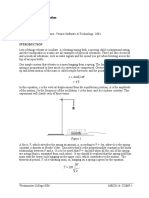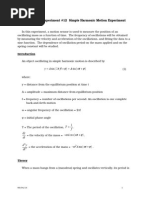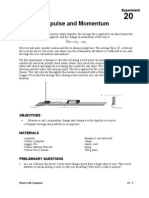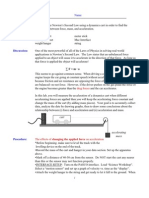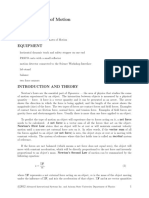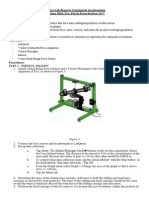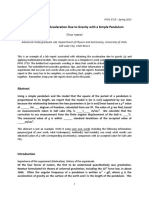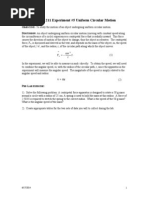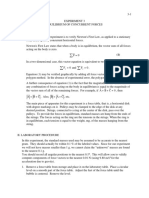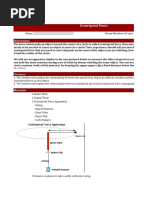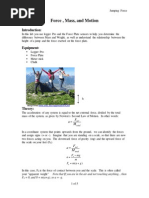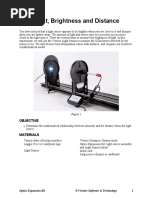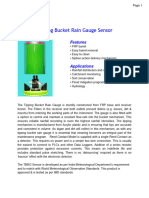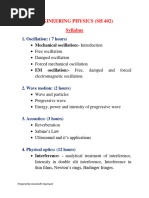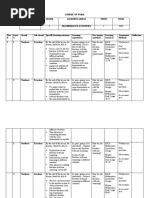15 Simple Harmonic Motn LQ
15 Simple Harmonic Motn LQ
Uploaded by
May ChanCopyright:
Available Formats
15 Simple Harmonic Motn LQ
15 Simple Harmonic Motn LQ
Uploaded by
May ChanOriginal Title
Copyright
Available Formats
Share this document
Did you find this document useful?
Is this content inappropriate?
Copyright:
Available Formats
15 Simple Harmonic Motn LQ
15 Simple Harmonic Motn LQ
Uploaded by
May ChanCopyright:
Available Formats
LabQuest
15
Simple Harmonic Motion
Lots of things vibrate or oscillate. A vibrating tuning fork, a moving child’s playground swing,
and the loudspeaker in a radio are all examples of physical vibrations. There are also electrical
and acoustical vibrations, such as radio signals and the sound you get when blowing across the
top of an open bottle.
One simple system that vibrates is a mass hanging from a spring. The force applied by an ideal
spring is proportional to how much it is stretched or compressed. Given this force behavior, the
up and down motion of the mass is called simple harmonic and the position can be modeled with
In this equation, y is the vertical displacement from the equilibrium position, A is the amplitude
of the motion, f is the frequency of the oscillation, t is the time, and is a phase constant. This
experiment will clarify each of these terms.
Figure 1
OBJECTIVES
Measure the position and velocity as a function of time for an oscillating mass and spring
system.
Compare the observed motion of a mass and spring system to a mathematical model of
simple harmonic motion.
Determine the amplitude, period, and phase constant of the observed simple harmonic
motion.
MATERIALS
LabQuest 200 g and 300 g masses
LabQuest App spring, with a spring constant of
Motion Detector approximately 10 N/m
ring stand, rod, and clamp twist ties
wire basket
Physics with Vernier 15 - 1
LabQuest 15
PRELIMINARY QUESTIONS
1. Attach the 200 g mass to the spring and hold the free end of the spring in your hand, so the
mass and spring hang down with the mass at rest. Lift the mass about 10 cm and release.
Observe the motion. Sketch a graph of position vs. time for the mass.
2. Just below the graph of position vs. time, and using the same length time scale, sketch a
graph of velocity vs. time for the mass.
PROCEDURE
1. Attach the spring to a horizontal rod connected to the ring stand and hang the mass from the
spring as shown in Figure 1. Securely fasten the 200 g mass to the spring and the spring to
the rod using twist ties so the mass cannot fall.
2. Place the Motion Detector about 50 cm below the mass. Make sure there are no objects near
the path between the detector and mass, such as a table edge. Place the wire basket over the
Motion Detector to protect it.
3. If your Motion Detector has a switch, set it to Normal. Connect the
Motion Detector to DIG 1 on LabQuest and choose New from the File
menu. If you have an older sensor that does not auto-ID, manually set up
the sensor.
4. Make a preliminary run to make sure things are set up correctly. Lift the mass upward about
five centimeters and release. The mass should oscillate along a vertical line only, and should
never come closer than 15 cm to the Motion Detector. Start data collection.
5. After five seconds, data collection will stop and a graph of position vs. time and velocity vs.
time will be displayed. The position graph should show a clean sinusoidal curve. If it has flat
regions or spikes, reposition the Motion Detector and try again.
6. Compare the position graph to your sketched prediction in the Preliminary Questions.
How are the graphs similar? How are they different?
7. Also, compare the velocity graph to your prediction.
8. Estimate the equilibrium position of the 200 g mass. Do this by finding the average of the
maximum and minimum distances from the Motion Detector. Read distances displayed to the
right of the graph by tapping any data point. Record this position (y0) in the data table.
9. Again using the position graph measure the time interval between maximum positions. This
is the period, T, of the motion. The frequency, f, is the reciprocal of the period, f = 1/T.
Based on your period measurement, calculate the frequency. Record the period and
frequency of this motion in the data table.
10. The amplitude, A, of simple harmonic motion is the maximum distance from the equilibrium
position. Estimate values for the amplitude from your position graph. Enter the values in
your data table.
11. Repeat Steps 4–10 with the same 200 g mass, with a larger amplitude than in the first run.
12. Change the mass to 300 g and repeat Steps 4–10. Use an amplitude of about 5 cm.
15 - 2 Physics with Vernier
Simple Harmonic Motion
DATA TABLE
Run Mass y0 A T f
(g) (m) (m) (s) (Hz)
Time Position
(s) (m)
when v = 0
when v is maximum
Model equation with parameters
ANALYSIS
1. View the graphs of the last run. Compare the position vs. time and the velocity vs. time
graphs. How are they the same? How are they different?
2. Tap the data points on the velocity graph to view the data values. In your data table, record a
time when the velocity is greatest and another time when the velocity is zero. Now switch to
the distance graph and tap the same two times. Record the position of the mass at these
times. Relative to the equilibrium position, where is the mass when the velocity is zero?
Where is the mass when the velocity is greatest?
3. Does the frequency, f, appear to depend on the amplitude of the motion? Do you have
enough data to draw a firm conclusion?
4. Does the frequency, f, appear to depend on the mass used? Did it change much in your tests?
5. You can compare your experimental data to the sinusoidal function model using an equation
entered in LabQuest. Try it with your 300 g data. The model equation in the introduction,
which is similar to the one in many textbooks, gives the displacement from equilibrium.
Your Motion Detector reports the distance from the detector. To compare the model to your
data, add the equilibrium distance to the model; that is, use
where y0 represents the equilibrium distance. The phase parameter is called the phase
constant and is used to adjust the y value reported by the model at t = 0 so that it matches
your data. To model this relationship with LabQuest, you will have to use roman letters for
all variables, or Y = A*cos(2**B*X + C ) + D.
a. Prepare to model your data by choosing Model from the Analyze menu.
b. Select the equation Acos(Bx+C)+D.
Physics with Vernier 15 - 3
LabQuest 15
6. To plot your data and the sinusoidal model on the graph at the same time,
a. For the A value, enter the amplitude you measured for Run 3.
b. For the B value, enter the frequency in Hz you determined for Run 3.
c. For the C value, initially enter 0. The optimum value for C, the phase term, will be
between 0 and 2You will adjust this parameter until the model comes very close to the
experimental data.
d. For the D value, enter the equilibrium position you measured for Run 3.
e. Adjust the C and D values until your model comes very close to the experimental data.
You may need to adjust A and B slightly from your measured values. Continue to adjust
the values until the model matches very closely with the experimental data.
f. Record the model equation with the four parameters in your data table.
g. Select OK.
Does the model fit the data well? How can you tell?
7. Predict what would happen to the plot of the model if you doubled the parameter for A (the
amplitude) by sketching both the current model and the new model with doubled A. Choose
Model from the Analyze menu and double the parameter for A to test your prediction.
8. Similarly, predict how the model plot would change if you doubled f, and then check by
modifying the model definition.
EXTENSIONS
1. Investigate how changing the spring amplitude changes the period of the motion. Take care
not to use a large amplitude so that the mass does not come closer than 40 cm to the detector
or fall from the spring.
2. How will damping change the data? Tape an index card to the bottom of the mass and collect
additional data. You may want to take data for more than 10 seconds. Does the model still fit
well in this case?
3. Do additional experiments to discover the relationship between the mass and the period of
this motion.
15 - 4 Physics with Vernier
You might also like
- Lab 12Document9 pagesLab 12Princes Katherine VergaraNo ratings yet
- Lab ReportDocument14 pagesLab ReportByron DizonNo ratings yet
- 19 Impulse and Momentum LQ - ModifiedDocument6 pages19 Impulse and Momentum LQ - ModifiedRaymond Zheng100% (1)
- Examples of The Laboratory Report: Hooke's Law ExperimentDocument8 pagesExamples of The Laboratory Report: Hooke's Law ExperimentKHAIRUNNISA' KHAIRUL AZRINNo ratings yet
- 15 Simple Harmonic MotionDocument4 pages15 Simple Harmonic Motionjohnhwang940% (1)
- Simple Harmonic MotionDocument5 pagesSimple Harmonic MotionMay ChanNo ratings yet
- Centripetal Acceleration Lab ReportDocument7 pagesCentripetal Acceleration Lab Reportapi-263389150No ratings yet
- Simple Harmonic Motion - ManualDocument5 pagesSimple Harmonic Motion - ManualMaimonh AlmamoryNo ratings yet
- Physics 221 Lab 4 Simple Harmonic Motion: A. Does The Period of The Motion Depend On The Amplitude?Document3 pagesPhysics 221 Lab 4 Simple Harmonic Motion: A. Does The Period of The Motion Depend On The Amplitude?ScionNo ratings yet
- Simple Harmonic MotionDocument6 pagesSimple Harmonic MotionVimal Nathan0% (2)
- Physics 211 Experiment #5 Uniform Circular MotionDocument6 pagesPhysics 211 Experiment #5 Uniform Circular MotionwwzNo ratings yet
- 201 Lab 10. Spring Mass OscillationsDocument8 pages201 Lab 10. Spring Mass OscillationsMa. YashNo ratings yet
- 201 Lab 10. Spring Mass OscillationsDocument8 pages201 Lab 10. Spring Mass OscillationsShanice ThompsonNo ratings yet
- Centripetal AccelerationDocument4 pagesCentripetal Accelerationapi-263388641No ratings yet
- PCS130 SimpleHarmonic 0Document7 pagesPCS130 SimpleHarmonic 0Ekan AhmadNo ratings yet
- Lab: Oscillations and The Simple PendulumDocument5 pagesLab: Oscillations and The Simple PendulumSean JonesNo ratings yet
- Barbie Bungee JumpDocument4 pagesBarbie Bungee JumpReeja MathewNo ratings yet
- Hookes Law Lab ActivityDocument4 pagesHookes Law Lab ActivityWeb BooksNo ratings yet
- Hooke's Law (George Ricarrson - 2501987261)Document11 pagesHooke's Law (George Ricarrson - 2501987261)George RYNo ratings yet
- 20 Impulse and MomentumDocument5 pages20 Impulse and MomentumRyan SheridanNo ratings yet
- One-Dimensional Motions ObjectivesDocument7 pagesOne-Dimensional Motions ObjectivesMark MoralNo ratings yet
- Lab 7 FreefallDocument4 pagesLab 7 FreefallAnonymous LGB1O2fANo ratings yet
- Lab Report Cen Force - 1Document5 pagesLab Report Cen Force - 1api-257247956No ratings yet
- Moment of Inertia and Conservation of Mechanical EnergyDocument6 pagesMoment of Inertia and Conservation of Mechanical EnergybrianNo ratings yet
- Lab 8-Impulse and MomentumDocument6 pagesLab 8-Impulse and MomentumlilcommishNo ratings yet
- 41 Spring and Mass OscillationsDocument4 pages41 Spring and Mass OscillationsLuis Gustavo Gaona GamaNo ratings yet
- Torque and Equilibrium Lab ReportDocument3 pagesTorque and Equilibrium Lab ReportHPK120% (5)
- Pendulum PeriodsDocument4 pagesPendulum PeriodsANGEL GUZMAN HERNANDEZNo ratings yet
- MOMENT OF INTERIA REPORT FINSLDocument9 pagesMOMENT OF INTERIA REPORT FINSLkilicaanilNo ratings yet
- Lab #10Document3 pagesLab #105377773No ratings yet
- Hooke's Law, Adding Forces and Resolving Forces - 2440060742 - Jeffrey LiandiDocument14 pagesHooke's Law, Adding Forces and Resolving Forces - 2440060742 - Jeffrey LiandiJeffrey LiandiNo ratings yet
- 17 Energy in Simple HarmonicDocument4 pages17 Energy in Simple HarmonicSara MolinaroNo ratings yet
- UPM Lab Manual B-TECHDocument20 pagesUPM Lab Manual B-TECHBismit MaharanaNo ratings yet
- Measurement of Gravitational Constant: Stephen TranovichDocument5 pagesMeasurement of Gravitational Constant: Stephen TranovichEnrayNo ratings yet
- Atwood Machine LQ CC NGSS PDFDocument4 pagesAtwood Machine LQ CC NGSS PDFGrace KimNo ratings yet
- Atwood'S Machine: LabquestDocument4 pagesAtwood'S Machine: LabquestGrace KimNo ratings yet
- ap-phys1_uniform-circular-motion-ap-free-response-problems_2024-11-22Document16 pagesap-phys1_uniform-circular-motion-ap-free-response-problems_2024-11-22SOHAM AGGARWALNo ratings yet
- Lab Newtons 2ndDocument3 pagesLab Newtons 2ndUgur ASİT50% (2)
- manualDocument8 pagesmanualAReal Shauniie BoyNo ratings yet
- Physics Lab Report - Centripetal AccelerationDocument4 pagesPhysics Lab Report - Centripetal Accelerationapi-257066694No ratings yet
- Determining The Acceleration Due To Gravity With A Simple PendulumDocument7 pagesDetermining The Acceleration Due To Gravity With A Simple Pendulumah maNo ratings yet
- Hookes'Law For Springs: QuestionsDocument2 pagesHookes'Law For Springs: Questionsanon_897851980No ratings yet
- Simple Harmonic Motion LabDocument4 pagesSimple Harmonic Motion LabDaniel Andres Canro CalderónNo ratings yet
- Circular Motion LabDocument6 pagesCircular Motion Labtham_psdcNo ratings yet
- Newtons 2nd LawDocument4 pagesNewtons 2nd Lawapi-275951526No ratings yet
- IIT Physics Lab Manual (Combined)Document34 pagesIIT Physics Lab Manual (Combined)Victoria Aschebrook-KealiherNo ratings yet
- Lab 5 Projectile MotionDocument6 pagesLab 5 Projectile Motionشب مغرورNo ratings yet
- Accelerated Motion Between Holding Magnet and Light BarrierDocument26 pagesAccelerated Motion Between Holding Magnet and Light BarrierLA LazarohNo ratings yet
- 06 Lab 6 Torque and Rotational Equilibrium DIYDocument5 pages06 Lab 6 Torque and Rotational Equilibrium DIYSaf Tanggo DiampuanNo ratings yet
- Physics Lab Effect of Mass of Hanging WeightDocument8 pagesPhysics Lab Effect of Mass of Hanging WeightSumeet RanuNo ratings yet
- Hooke's Law Experiment3Document6 pagesHooke's Law Experiment3bingthekingNo ratings yet
- Picket Fence Freefall LabDocument4 pagesPicket Fence Freefall Labasdf100% (1)
- Lab 03Document3 pagesLab 03Ranu GamesNo ratings yet
- LAB 3 Newtons 2nd Law of Motion.9!8!06.DchDocument6 pagesLAB 3 Newtons 2nd Law of Motion.9!8!06.DchRodilyn ParreñoNo ratings yet
- Centripetal Force: InstructionsDocument8 pagesCentripetal Force: InstructionsJoel Christian MascariñaNo ratings yet
- Force, Mass, and Motion: F MG A M F Ma GDocument5 pagesForce, Mass, and Motion: F MG A M F Ma GEmmad AnsariNo ratings yet
- Movimiento Armonico SimpleDocument6 pagesMovimiento Armonico SimpleFrancisco Manuel Ugarte PalacinNo ratings yet
- 05 Picket Fence Free Fall LQDocument4 pages05 Picket Fence Free Fall LQNayeli CarrascoNo ratings yet
- A-level Physics Revision: Cheeky Revision ShortcutsFrom EverandA-level Physics Revision: Cheeky Revision ShortcutsRating: 3 out of 5 stars3/5 (10)
- Understanding Vector Calculus: Practical Development and Solved ProblemsFrom EverandUnderstanding Vector Calculus: Practical Development and Solved ProblemsNo ratings yet
- 04 Determining G On Incline-ModDocument3 pages04 Determining G On Incline-ModMay ChanNo ratings yet
- What To Say Upon Being Asked To Be Friends by - Poetry FoundationDocument2 pagesWhat To Say Upon Being Asked To Be Friends by - Poetry FoundationMay ChanNo ratings yet
- OEK-01-light and DistanceDocument6 pagesOEK-01-light and DistanceMay ChanNo ratings yet
- Notes 3-3Document13 pagesNotes 3-3May ChanNo ratings yet
- AB Review 04 MC SolutionsDocument3 pagesAB Review 04 MC SolutionsMay ChanNo ratings yet
- 13854-Article Text-53672-1-10-20140811Document4 pages13854-Article Text-53672-1-10-20140811May ChanNo ratings yet
- 8 3A Worksheet SolutionsDocument8 pages8 3A Worksheet SolutionsMay ChanNo ratings yet
- 2u85x5w3 WR PDFDocument6 pages2u85x5w3 WR PDFMay ChanNo ratings yet
- King Lear LanguageDocument3 pagesKing Lear LanguageMay ChanNo ratings yet
- Solar Based Thermoelectric Refrigerator Using Peltier ModuleDocument6 pagesSolar Based Thermoelectric Refrigerator Using Peltier ModuleIJRASETPublicationsNo ratings yet
- (1-03) Spesifikasi BTL-4825SL Premium + Complete Applicator + TrolleyDocument2 pages(1-03) Spesifikasi BTL-4825SL Premium + Complete Applicator + TrolleyFardiyan SyafriNo ratings yet
- Applied Maths 2020-2011Document75 pagesApplied Maths 2020-2011Kenura R. GunarathnaNo ratings yet
- DJJ2022 - Electrical Technology: LAB 1: Analog MultimeterDocument8 pagesDJJ2022 - Electrical Technology: LAB 1: Analog MultimeterSakinah KamalNo ratings yet
- Tipping Bucket Rain GaugesDocument2 pagesTipping Bucket Rain GaugesPoonam ShuklaNo ratings yet
- Circular Steel Tank Design CalculationDocument9 pagesCircular Steel Tank Design CalculationRathika100% (1)
- Ohms Law QuestionDocument12 pagesOhms Law QuestionlemNo ratings yet
- Colorimetry and Spectrometry Multiple Choice Questions and AnswersDocument23 pagesColorimetry and Spectrometry Multiple Choice Questions and AnswersmakayimaselaNo ratings yet
- To Calculate The Exit Air Humidity and TemperatureDocument2 pagesTo Calculate The Exit Air Humidity and Temperaturedummy9158No ratings yet
- Waves P-1Document20 pagesWaves P-1anusha gNo ratings yet
- Exercises CeDocument3 pagesExercises CeLethal Al'dvlNo ratings yet
- Units and MeasurmentsDocument6 pagesUnits and MeasurmentsShiva Sankar BeharaNo ratings yet
- PhysicsDocument395 pagesPhysicsLamu YogeshNo ratings yet
- Thermodynamics Question Bank 1693823597402Document59 pagesThermodynamics Question Bank 1693823597402adityasingh273158No ratings yet
- Mechanical Properties of Fluids - Short Notes - Arjuna JEE 2.0 2024Document2 pagesMechanical Properties of Fluids - Short Notes - Arjuna JEE 2.0 2024SGC Crunch WorksNo ratings yet
- Physical Chemistry: Instructor's Solutions Manual ForDocument10 pagesPhysical Chemistry: Instructor's Solutions Manual ForLauraNo ratings yet
- Measurement IDocument3 pagesMeasurement ITitus KaselaNo ratings yet
- Topic 1 & 2 Exam Questions Paper1Document9 pagesTopic 1 & 2 Exam Questions Paper1Hamza Ahmed YahiaNo ratings yet
- Standard Test Methods For Maximum Index Density and Unit Weight of Soil Using A Vibratory (ASTM D4253)Document5 pagesStandard Test Methods For Maximum Index Density and Unit Weight of Soil Using A Vibratory (ASTM D4253)April Joy PerezNo ratings yet
- Zeeman EffectDocument13 pagesZeeman EffectRamu GanguNo ratings yet
- Lecture Planner-Physics: S.No. Subject Chapter Name Sub Topic Lecture No. Total No. of Lectures Date Date of CompletionDocument5 pagesLecture Planner-Physics: S.No. Subject Chapter Name Sub Topic Lecture No. Total No. of Lectures Date Date of CompletionSatyam MohantyNo ratings yet
- DEVELOP Pemeriksa Sistem Alat Ukur Serah Terima Gas Bumi Training NSDocument3 pagesDEVELOP Pemeriksa Sistem Alat Ukur Serah Terima Gas Bumi Training NSProject Engineers CourseNo ratings yet
- 2023grade 5 Mentor Mathematics Schemes of Work Term 2-06-23 Feb 09-55-04Document22 pages2023grade 5 Mentor Mathematics Schemes of Work Term 2-06-23 Feb 09-55-04ENGINEER VERONICAHNo ratings yet
- PHYS 1002 General Physics HW2Document3 pagesPHYS 1002 General Physics HW2HIN SONo ratings yet
- CIRCULAR MOTION 25 Imp McqsDocument4 pagesCIRCULAR MOTION 25 Imp Mcqskshitijchavan1018No ratings yet
- 2nd Order ExampleDocument25 pages2nd Order ExampleMagdy RiadNo ratings yet
- Lavatory 3Document14 pagesLavatory 3JAN JERICHO MENTOYNo ratings yet
- Lec 4 HarmonicsDocument53 pagesLec 4 HarmonicsÙdayà Nirrmàl FernàñdòNo ratings yet
- 2021 MRSM Physics K1 - K2 JawapanDocument14 pages2021 MRSM Physics K1 - K2 Jawapan黎筱淳No ratings yet
- 12th Class Notes 2024 Phy CH No 12Document37 pages12th Class Notes 2024 Phy CH No 12larkii747No ratings yet





